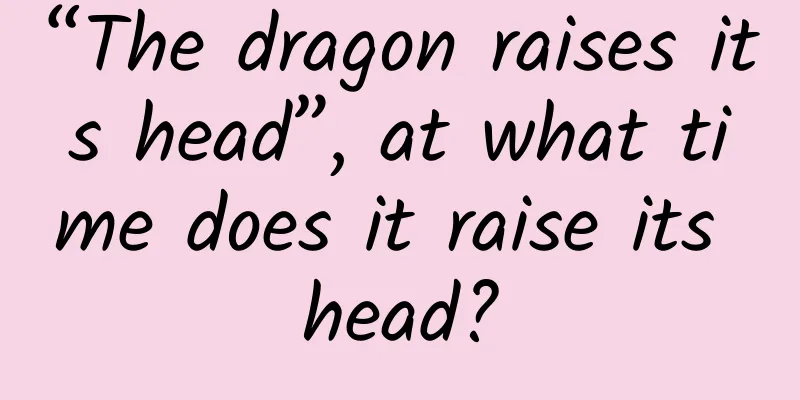“The dragon raises its head”, at what time does it raise its head?

|
February 21st marks the day when the Dragon raises its head. According to astronomical science experts, this year's Dragon raises its head around 10 p.m. What does "Dragon raises its head" mean? At what time can we see it? Wang Kechao, the director of science popularization at the Purple Mountain Observatory of the Chinese Academy of Sciences, introduced that in order to observe celestial phenomena, ancient Chinese people divided the stars in the celestial equator and the ecliptic into 28 star groups, called the 28 Mansions. Among the 28 Mansions, each group consists of seven: the eastern one is the Azure Dragon, the southern one is the Vermillion Bird, the western one is the White Tiger, and the northern one is the Black Tortoise. "The Eastern Azure Dragon includes seven constellations, namely Jiao, Kang, Di, Fang, Xin, Wei and Ji, which vividly outline the image of a dragon: Jiao is the head of the dragon, Kang is the neck, Di is the chest, Fang is the belly, Xin is the body, and Wei and Ji together represent the tail of the dragon." Wang Kechao said, "The Dragon Raising its Head" reflects the image of Jiao rising from the eastern horizon, as if the "head of the dragon" has been raised. About 2,000 years ago, the ancient Chinese saw the "Dragon Raising its Head on the Second Day of the Second Month" shortly after sunset. Due to the precession of the equinoxes, people today generally see the "Dragon Raising its Head" at around 8 or 9 p.m. on the second day of the second month of the lunar calendar. This year, the time to see the "dragon raising its head" is relatively later, around 10 o'clock in the evening. Wang Kechao explained that in addition to the influence of the precession of the equinoxes over the years, the time when the same stellar phenomenon appears in a day is also related to the early or late Gregorian calendar date. The same star rises about 4 minutes earlier every day than the previous day. The second day of the second month of the lunar calendar this year corresponds to the Gregorian calendar date of February 21. The time of "dragon raising its head" on that day is more than an hour later than "February 2, dragon raising its head" on March 14, 2021. In the nearly two months after the second day of the second lunar month, the public can see the "dragon head" Jiao Su rising from the horizon at different times of the night. It takes about 6 hours for the entire "Cang Long" to rise from the horizon. From mid-July to mid-October of the Gregorian calendar, the public can see the entire "dragon shape" of Cang Long appear in the night sky after dark. |
<<: Spring is here. Are you doing the right thing to make your child taller?
>>: Spring is here, how can we move scientifically?
Recommend
What is the situation under which people from other places stranded in Wuhan can apply for 3,000 yuan in government aid? What are the basic conditions for the subsidy?
Due to the city lockdown in Wuhan before the Spri...
How to name a brand, here are 6 tips!
Written at the beginning: The success of big bran...
How much of your knowledge of psychology is reliable?
Don't trust any single research result at fac...
Since I used this player, I feel that all the movies I watched before were wasted.
I wonder how many people in front of the screen l...
The only cancer in the world that can be prevented by a vaccine! Should men get vaccinated?
Expert of this article: Hu Zhongdong, Chief Physi...
Using golden apple snails to impersonate field snails and sell them? One golden apple snail contains 6,000 parasites!
Crowd terror warning! Crowd terror warning! Some ...
What’s the matter with Beijing issuing six new regulations? Beijing issued six new regulations
Notice of the Beijing Novel Coronavirus Pneumonia...
What are the functions of Lanzhou Pet Mini Program? How to develop a pet store mini program?
Nowadays, more and more people like to keep pets, ...
Qoros Model Young SUV debuts at Guangzhou Auto Show: its last act before being abandoned by Chery?
At the 2017 Guangzhou Auto Show, Chery officially...
Deconstructing the user life cycle of Toutiao
1. Product Introduction Toutiao is a recommendati...
The only difference between "social phobia" and "social bull" is a greeting
Editor's note: If you open the search softwar...
Useful Information | General Process for Online Event Operation and Promotion
There is no clear definition of operation and spe...
There is good news about controlled nuclear fusion. When will humans break through this curse? Three major questions remain unresolved
Author: Gan Shudong (Science Rocket Uncle) On Dec...
OPPO Pad Air review: A cost-effective beast that emerged amid the trend of large-screen mobile phones and thin and light PCs
In the tablet computer field, whether it is Apple...
A complete operation and promotion plan planning idea!
First of all, we must understand that any plan mu...









